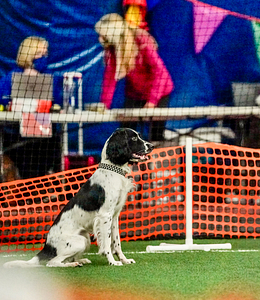As a handler, there are few things more frustrating in agility than an unreliable start line stay.
As a dog agility instructor, there are few things more frustrating to me than a handler blaming their dog for a broken start line. Remember that your dog’s behavior is a reflection of your ability to teach and maintain criteria.
Here are three common ways handlers deteriorate their dog’s start line stay behavior. By learning to avoid these mistakes, you’ll keep your dog’s start line strong.
 Release With a Flourish
Release With a Flourish
In this scenario, the handler moves her hand (usually) or head at the same time she gives her dog’s release cue.
This deteriorates your dog’s start line because all dogs pay more attention to our body language than our verbal cues, unless they have been explicitly trained to ignore our bodies and only listen. (This is why it’s so difficult to train reliable verbal cues in agility that override our physical cues.)
To prevent this error, it is helpful to video tape at least some of your training runs, or have someone with a good eye watch you in practice. It does not take much coaching for a friend or family member to see you commit the “release-n-wave” behavior. If you can’t “see” it, watch your agility videos on mute and focus on your body. Do you flick your head back or raise your arm at the same moment your mouth opens to give the verbal cue?
If you find yourself doing this, practice in front of a mirror. Remind yourself: “release and then move.”
(Note: In the same vein, it’s actually “legal” – as in, not confusing to your dog – to jog or sprint from the start line and release your dog while you stay in motion. The key is to be consistent, and not give your release cue and introduce a new physical cue at the same time.)
Creep Out
In this scenario, the handler slowly, carefully backs away from her dog on the start line and either gives the release cue after the dog has already started to move, or has abandoned the release cue entirely and just starts running when the dog does.
Creeping away from your dog can make him hyper-sensitive to your motion. Almost every handler that I see creeping away from their dog follows this up by blurting out a release cue while simultaneously turning 180 degrees away from the dog and running away.
Very quickly, the dog starts to watch for that shoulder rotation away that predicts the release cue is coming. In short order, you’ve got a dog that will launch forward at the slightest turn of the shoulders or arm movement.
Another side-effect of the creeping handler is boredom. Dogs that have a lot of environmental focus are likely to disconnect during long, drawn-out start lines. Move briskly to keep your dog’s attention, and train him to accept this movement without breaking.
Let it Slide
In this scenario, the handler starts to allow the dog to break his start line stay without a release cue in class or at trials because she is too focused on the rest of the sequence. In her rush to “get to the good part” and work on handling maneuvers or earn qualifying scores, she lets these self-releases slide.
Of the three errors I’ve outlined here, this is the one that most handlers do realize they are making. Somehow they think they can get consistent later, that they can put the start line on the back burner and fix it further down the line.
While that’s possible, you’re making it tremendously more difficult for yourself and more confusing for your dog. Train a start line stay correctly from day one – it’s a great skill to work on with puppies! – and then you just have to maintain it for the rest of your dog’s career. When trained properly in the first place, it is not difficult at all to maintain. Retrains are a little trickier, but the sooner you get consistent with your criteria, the sooner the behavior becomes reliable.
Ask yourself what matters more to you: what you want right now (to run this course) or what you want for a lifetime (a reliable start line stay). Choose accordingly!
Fixing Your Start Line Stay
If you’re having trouble with your start line stays, revisit my post Agility is a Behavior Chain to figure out your new game plan. Ask yourself: does your dog actually want you to return to him on the start line and give him a cookie, or would he find it more reinforcing to get his release cue to have access to the obstacle?
Bad Dog Agility has also produced a variety of resources for start line stays if you need an in-depth how-to. Good luck, and happy training!
This blog post was originally published in 2014, then lost for many years due to a website crash. Thanks to The Wayback Machine, we were able to save it! It’s been lightly edited for clarity and re-published.

 Release With a Flourish
Release With a Flourish